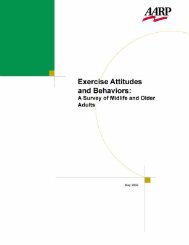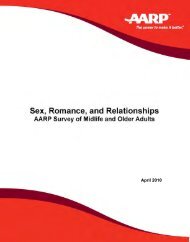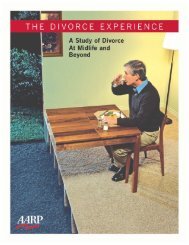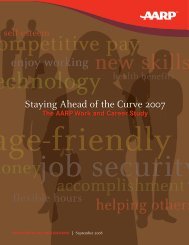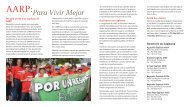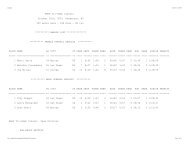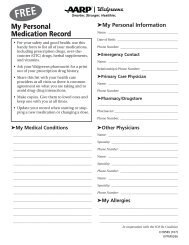The New Aging Enterprise - aarp
The New Aging Enterprise - aarp
The New Aging Enterprise - aarp
Create successful ePaper yourself
Turn your PDF publications into a flip-book with our unique Google optimized e-Paper software.
activities of daily living. <strong>The</strong>se are small, family-size homes for six to eight residents, supported<br />
by paid caregivers, six hours per day, who also serve as homemaker and friend. A licensed<br />
practical nurse is on call 24 hours a day, and back-up technology aims to reduce paperwork and<br />
improve the quality of care. This new model of community-based long-term care emphasizes a<br />
“warm, smart, and green” approach. In effect, it de-institutionalizes long-term care and returns it<br />
to a more human scale, as proponents of community-based long-term care have long<br />
advocated. 34 Whether in an Edenized facility or in a Green House, this new vision of long-term<br />
care attempts an affirmative and visionary answer to the question: “What are old people for?” 35<br />
<strong>The</strong> answer we give will be an important part of the <strong>New</strong> <strong>Aging</strong> <strong>Enterprise</strong> in years to come.<br />
Policy Perspectives. <strong>The</strong> success of the Eden Alternative and On Lok should be seen in<br />
the context of the larger political economy of long-term care. 36 For example, in the past few<br />
years, large private investment groups have acquired 6 of the 10 largest nursing home chains, or<br />
9% of the total in the USA; private investment groups own smaller chains and are likely to<br />
acquire more companies in the future. This trend reveals a significant dimension of the political<br />
economy of long-term care because huge public expenditures are at stake: nursing homes<br />
receive more than $75 billion each year from Medicare and Medicaid, and private investors are<br />
reaping huge profits.<br />
Ominously, this trend toward corporate takeovers has been accompanied by declining<br />
quality of care. Federal and state regulators point out that, since 2000, serious quality-of-care<br />
deficiencies have risen at every large nursing home chain after the chain was acquired by a<br />
private investment group. During this same period, citations for deficiencies were declining at<br />
other homes and chains. Big money is at stake in these corporate takeovers of nursing home<br />
chains. For example, in 2006, a chain of 185 facilities was sold to General Electric for $1.4<br />
billion. 37 We must wonder that at a time when private investors are cutting staff in nursing homes,<br />
will they be interested in genuine “culture change” represented by the Eden Alternative and On Lok?<br />
What Eden and On Lok have shown is that long-term care can be transformed in far-reaching ways.<br />
Whether that promise can be fulfilled is a question for the future. 38<br />
Health Promotion<br />
According the National Institutes of Health, nearly 55 percent of Americans are<br />
overweight, and some 22 percent are obese, with rates even higher for Americans over age 50.<br />
In fact, there is an ominous trend toward obesity among aging Baby Boomers. 39 <strong>The</strong>se facts<br />
underscore that innovation is needed for health promotion in an aging society. 40 In 2007, the<br />
American Heart Association and the American College of Sports Medicine published joint<br />
guidelines for physical activity and health, suggesting that 30 minutes of moderate physical<br />
activity five days a week is necessary to “promote and maintain health.” Concurrently, the US<br />
Institute of Medicine and the International Association for the Study of Obesity, along with the<br />
US Department of Agriculture (USDA), recommend exercise for up to 60 minutes a day to avoid<br />
what the USDA calls “unhealthy weight gain.”<br />
12



